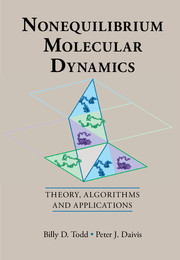Book contents
- Frontmatter
- Contents
- Preface
- 1 Introduction
- 2 Nonequilibrium Thermodynamics and Continuum Mechanics
- 3 Statistical Mechanical Foundations
- 4 Temperature and Thermodynamic Fluxes
- 5 Homogeneous Flows for Atomic Fluids: Theory
- 6 Homogeneous Flows for Atomic Fluids: Applications
- 7 Homogeneous Heat and Mass Transport
- 8 Homogeneous Flows for Molecular Fluids
- 9 Inhomogeneous Flows for Atomic Fluids
- 10 Confined Molecular Fluids
- 11 Generalised Hydrodynamics and Slip
- Bibliography
- Index
3 - Statistical Mechanical Foundations
Published online by Cambridge University Press: 30 March 2017
- Frontmatter
- Contents
- Preface
- 1 Introduction
- 2 Nonequilibrium Thermodynamics and Continuum Mechanics
- 3 Statistical Mechanical Foundations
- 4 Temperature and Thermodynamic Fluxes
- 5 Homogeneous Flows for Atomic Fluids: Theory
- 6 Homogeneous Flows for Atomic Fluids: Applications
- 7 Homogeneous Heat and Mass Transport
- 8 Homogeneous Flows for Molecular Fluids
- 9 Inhomogeneous Flows for Atomic Fluids
- 10 Confined Molecular Fluids
- 11 Generalised Hydrodynamics and Slip
- Bibliography
- Index
Summary
A detailed microscopic description of nonequilibrium classical mechanical systems can be achieved through the methods of nonequilibrium statistical mechanics. Beginning with the development of the Green–Kubo relations in the 1950s, modern nonequilibrium statistical mechanics has now reached a high level of sophistication, culminating in time-dependent nonlinear response theory and the derivation of fluctuation theorems. Several different approaches to nonequilibrium statistical mechanics that have slightly different fundamental perspectives have been developed. Some examples of these differing approaches can be seen in the books by McLennan [37], Eu [38], Zwanzig [39], Zubarev [40] and Gaspard [41]. The methodology we will use closely follows Evans and Morriss [2]. It evolved in close connection with the development of many of the nonequilibrium molecular dynamics simulation algorithms discussed in this book, and it is particularly suitable for our discussion. Readers seeking a broader introduction to nonequilibrium statistical mechanics are advised to consult the references provided.
Fundamentals of Classical Mechanics
Equations of Motion
Before proceeding with our discussion of nonequilibrium statistical mechanics, we will introduce the main concepts of classical mechanics. This will allow us to establish our notation and some basic ideas before moving on to the more complex material that follows. The simplest and most familiar formulation of classical mechanics for a single particle is based on Newton's second law of mechanics,
where m is the particle's mass, r is its position and ris its velocity. The total force FT may be a function of the particle's position, velocity and may also be an explicit function of time. For a system of interacting particles, the equation of motion for particle i may be a function of the positions and velocities of all other particles in the system, as well as an explicit function of time. The Lagrangian and Hamiltonian formalisms are richer and more elegant formulations of classical mechanics.
- Type
- Chapter
- Information
- Nonequilibrium Molecular DynamicsTheory, Algorithms and Applications, pp. 31 - 58Publisher: Cambridge University PressPrint publication year: 2017



